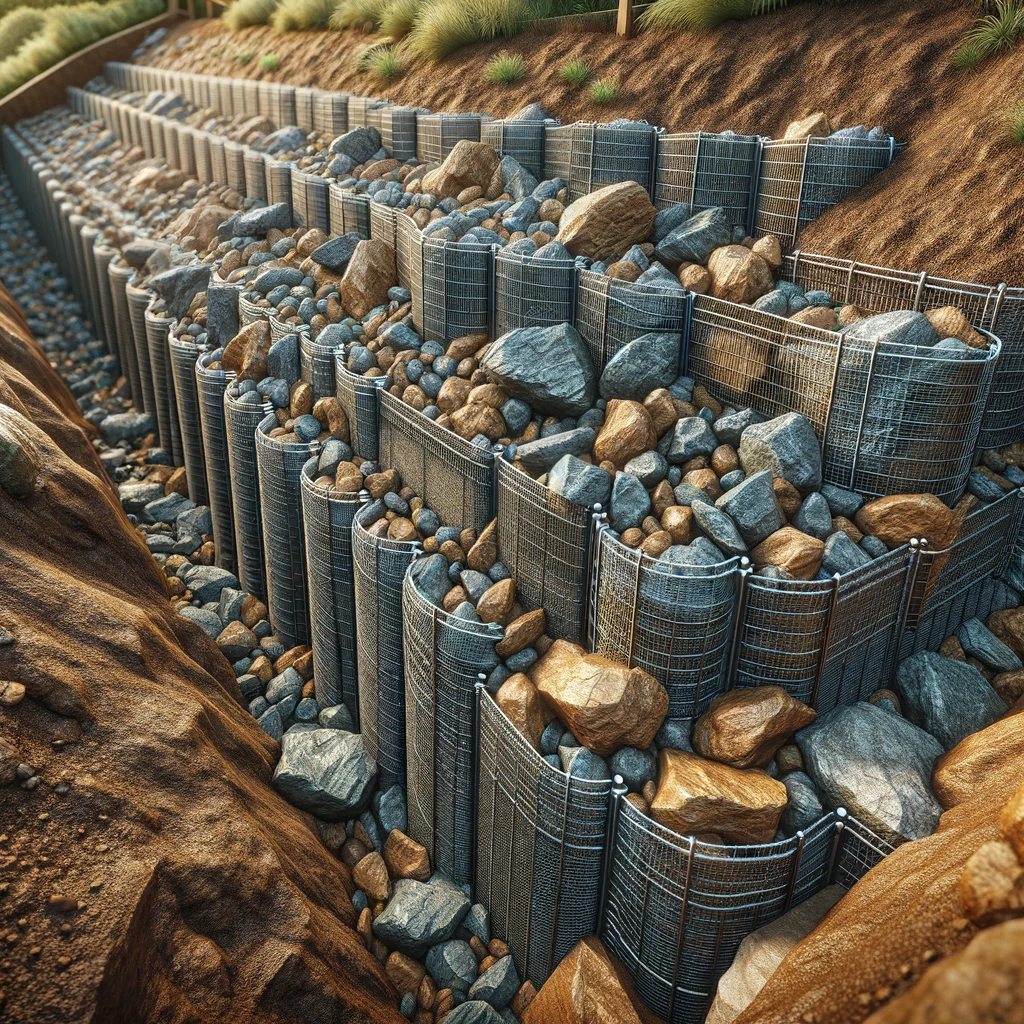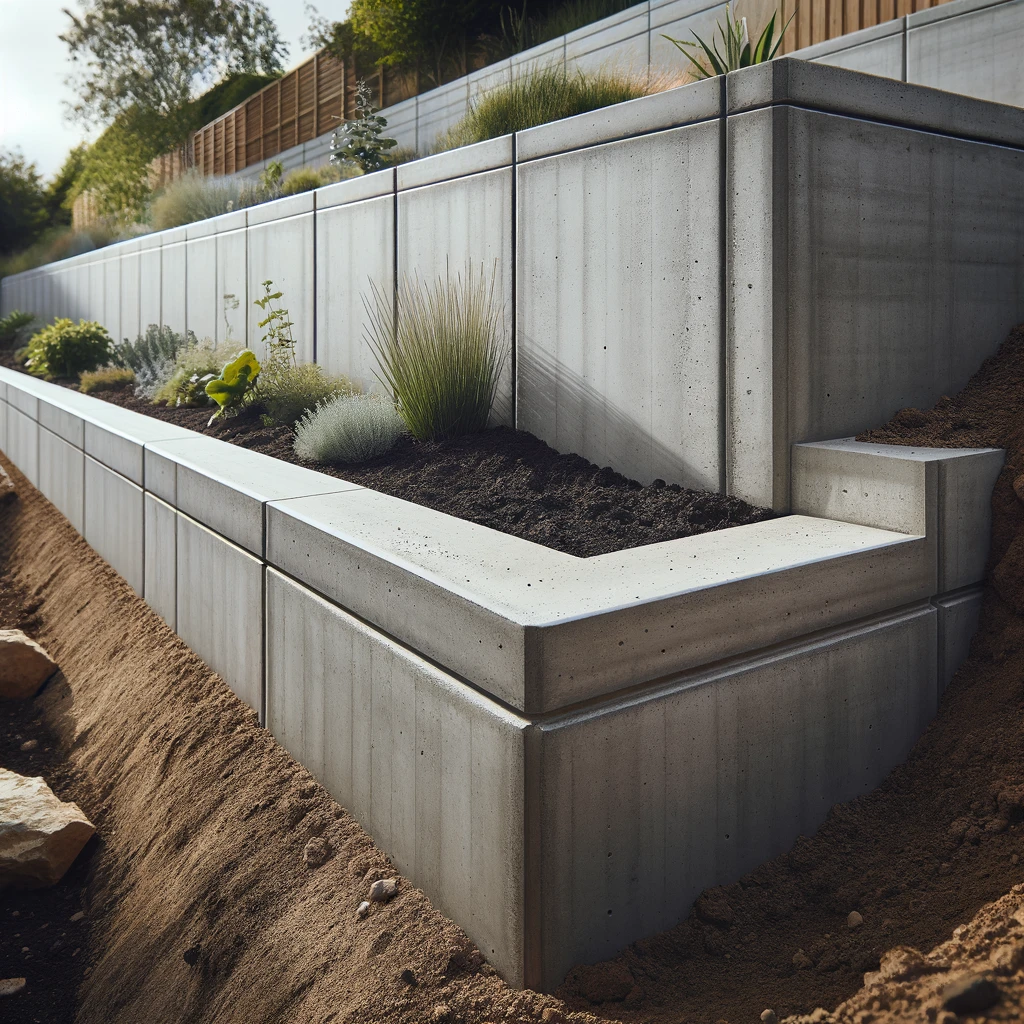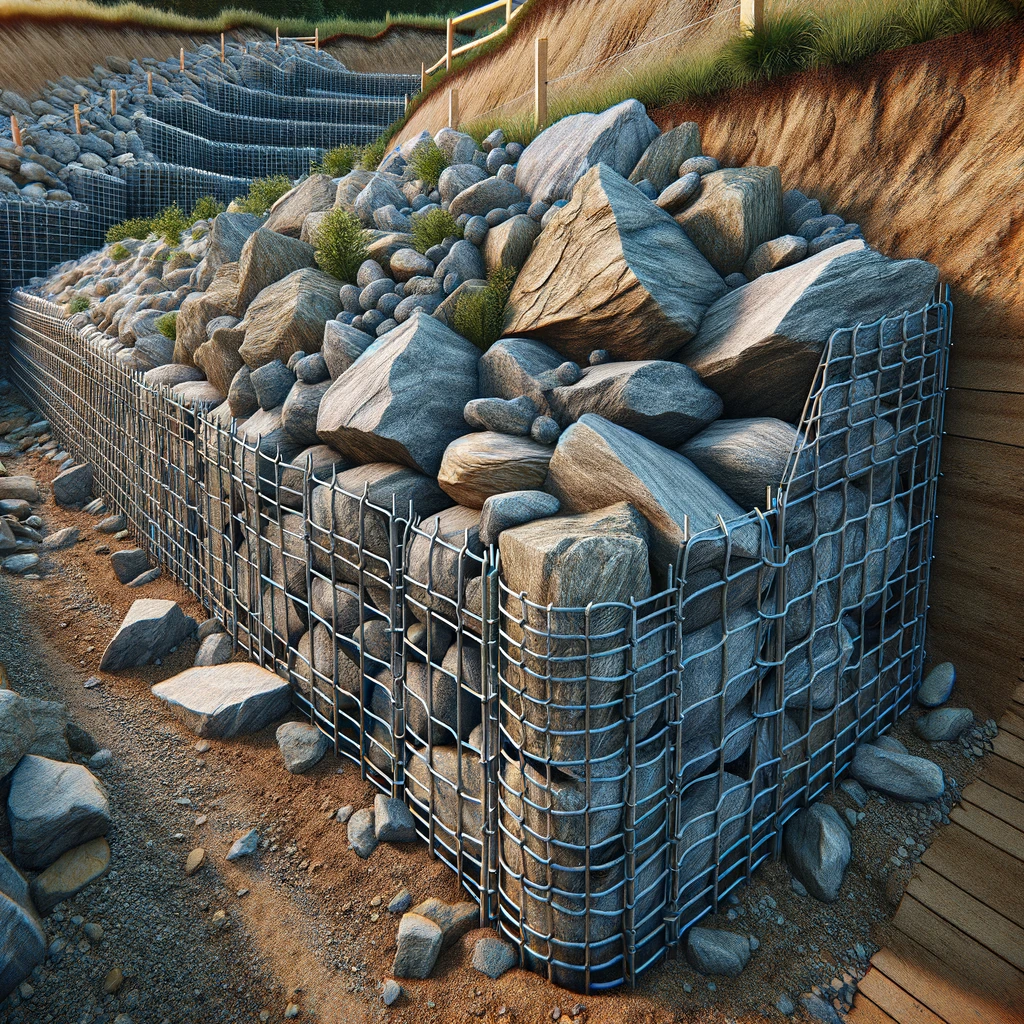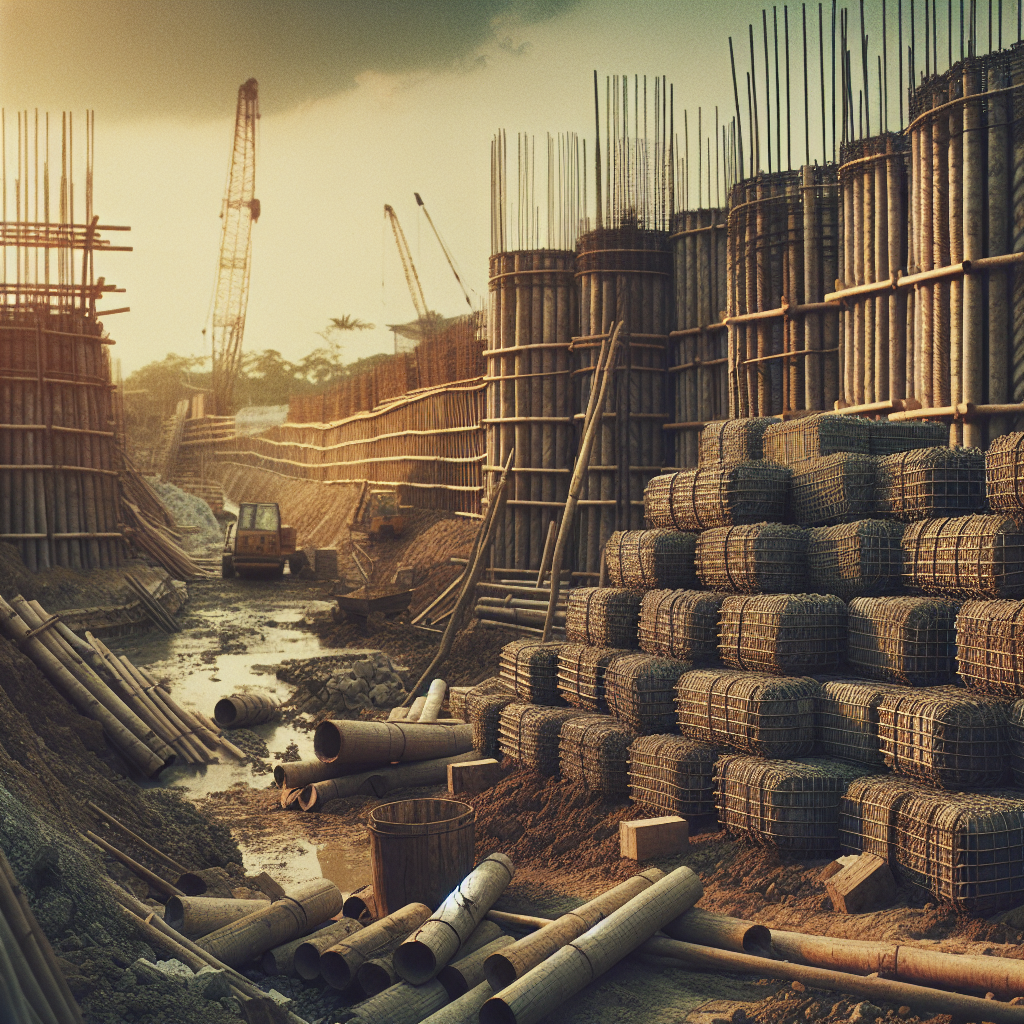Introduction to Gabion Retaining Walls
Ever wondered what those stacked stone-filled cages you see in construction sites are?
Well, they’re called Gabion Retaining Walls, and they’re a fantastic solution for soil retention and erosion prevention. This article will cover everything you need to know about these structures, including their materials, the different types available, the construction process, advantages, and common uses.
Plus, we’ll also compare gabion walls to other types of retaining walls, discuss their cost and maintenance, and even explore their life expectancy.
So, are you ready to learn more about these robust and environmentally-friendly structures?
Let’s get started!
Table of Contents
Gabion Retaining Wall Explained

Introduction to Gabion Retaining Walls
A gabion retaining wall is a structure made from stacked stone-filled cages, usually with steel mesh. These walls are used in construction to retain soil and prevent erosion. They are popular due to their durability, flexibility, and natural appearance.
Materials Used in Gabion Retaining Walls
- Steel Mesh: Typically made of galvanized or stainless steel to resist corrosion.
- Rock Fill: Commonly river rock, crushed stone, or other durable materials that fit well within the mesh.
Types of Gabion Walls
- Gravity Gabion Walls: Use their weight to retain soil.
- Mechanically Stabilized Earth (MSE) Walls: Include reinforcement to stabilize the soil mass.
Design and Construction
Constructing a gabion retaining wall involves several steps:
- Excavation: Digging a trench for the wall’s base.
- Foundation Preparation: Ensuring a solid, level base, sometimes with a concrete layer.
- Assembly: Filling steel cages with rock and stacking them in place.
- Anchoring: Securing the cages and layers when necessary, often using metal rods or ties.
Advantages of Gabion Retaining Walls
There are several benefits to using gabion retaining walls in construction:
| Benefit | Description |
|---|---|
| Durability | Resistant to weather and environmental conditions. |
| Flexibility | Can conform to ground movement and settling. |
| Permeability | Allows water to pass through, reducing hydrostatic pressure. |
| Eco-friendly | Uses natural materials and integrates well into landscapes. |
Common Applications
Gabion retaining walls are used in various settings, including:
- Road and Highway Projects: Stabilizing slopes and embankments.
- Landscaping: Creating terraced gardens and erosion control.
- Riverbank Protection: Preventing erosion along waterways.
Cost and Maintenance
Gabion walls are relatively cost-effective. They require minimal maintenance, but it’s essential to inspect them periodically for any signs of damage or mesh corrosion.
Introduction to Retaining Walls

A Basic Overview
Retaining walls are structures designed to restrict soil to a slope that it would not naturally maintain, typically on uneven terrain. These walls also aid in controlling downhill erosion or even manage water runoff; they essentially retain (hence the term) the soil behind them.
Materials Used in Retaining Walls
- Concrete: Pre-cast concrete blocks or poured concrete offer durability and strength.
- Timber: Wood or timber is often opted for due to its cost-effectiveness and aesthetic appeal, although it may not last as long as alternative materials.
- Stone or Brick: Natural stone or brick provide design flexibility and can create beautiful, sturdy walls.
Types of Retaining Walls
- Gravity Retaining Walls: Just like gravity gabion walls, gravity retaining walls use their weight to hold back the soil.
- Cantilever Walls: Use lever mechanics with a base connected to a slab extending into the earth to resist pressure.
Design and Construction
The construction of a retaining wall differs from that of a gabion wall and includes steps like:
- Trench Excavation: Similar to gabion walls, a trench is dug for the wall’s base.
- Wall Construction: The actual building of the wall with the chosen material.
- Drainage Installation: Drainage systems are important to prevent water buildup behind the wall.
- Backfill: This involves adding soil or gravel behind the wall.
Advantages of Retaining Walls
Surprisingly, retaining walls share some of the same benefits as gabion walls:
| Benefit | Description |
|---|---|
| Functionality | Effective at containing soil, preventing erosion, and managing water runoff. |
| Design Flexibility | Various options for materials and styles to complement any landscape. |
| Durability | Often last many years, especially when constructed with sturdy materials. |
| Increased Land Usage | Can create additional usable space on slopes or uneven terrain. |
Common Applications
Retaining walls are also used in a broad range of applications including:
- Residential Landscaping: From combating erosion to creating aesthetic garden beds.
- Commercial Landscaping: Often employed in large-scale projects like office parks or shopping centers.
- Infrastructure: Utilized in street design, highway projects, or to reinforce land around structures.
Cost and Maintenance
Retaining walls can vary greatly in cost, based on factors like material type, wall height, and labor requirements. Proper drainage and periodic inspection are critical to maintaining the lifespan of a retaining wall.
To expand your knowledge further, feel free to read this The Spruce article. It provides comprehensive coverage of retaining walls and their application.
Are Gabion Walls Effective Retaining Walls?

Structural Efficiency of Gabion Retaining Walls
Gabion walls are incredibly effective as retaining walls due to their unique structural characteristics. The combination of their heavy weight and permeability makes them particularly adept at handling pressure and managing water flow.
Load-Bearing Capacity
Gabion walls excel in load-bearing capabilities. The interlocking nature of rocks within the steel mesh means each unit acts as a single, solid mass. This provides substantial resistance against the lateral forces imposed by soil.
Hydraulic Performance
Water management is a critical concern in retaining wall construction. Gabion walls are advantageous because they are permeable, allowing water to pass through them and thus reducing hydrostatic pressure behind the wall. This makes them ideal for areas with high water tables or frequent rainfall.
Environmental Benefits
Besides their structural benefits, gabion walls offer several environmental advantages:
- Eco-friendly: The use of locally sourced rock fills minimizes transportation emissions.
- Vegetation: Over time, vegetation can grow between the rocks, enhancing ecological integration and providing a natural aesthetic.
Cost Considerations
While gabion walls can be cost-effective in terms of materials, labor costs can vary. Here are some factors to consider:
| Cost Factor | Details |
|---|---|
| Materials | Locally sourced rock fills are often inexpensive. |
| Labor | Assembly requires less specialized skills but can be labor-intensive due to manual filling and stacking. |
| Maintenance | Periodic inspections for mesh corrosion are essential, but overall maintenance is minimal. |
Design Versatility
Gabion retaining walls offer a range of design options to fit various landscapes and project requirements:
- Modular Design: Can be easily adapted in size and shape to fit specific site conditions.
- Aesthetics: Blend naturally into surroundings, particularly with added vegetation.
Comparing Gabion Walls to Other Retaining Walls
Let’s compare gabion walls to other common types of retaining walls in terms of different characteristics:
| Characteristic | Gabion Walls | Concrete Retaining Walls | Timber Retaining Walls |
|---|---|---|---|
| Cost | Moderate | High | Low |
| Durability | High | High | Low |
| Aesthetic Options | Natural, Rustic | Modern, Polished | Natural, Rustic |
| Environmental Impact | Low | Moderate | Moderate |
| Water Management | Excellent | Moderate (requires drainage systems) | Poor (requires drainage systems) |
For more in-depth insights, you can refer to this comprehensive guide on gabion retaining walls from ConstructConnect.
How Long Do Gabion Retaining Walls Last?
Factors Influencing Longevity
The lifespan of gabion retaining walls can vary based on several factors:
- Quality of Materials: Using high-quality galvanized or stainless steel mesh can significantly increase the wall’s lifespan. Poor-quality meshes are more prone to rust and breakage.
- Environmental Conditions: Areas with high moisture, acidic soils, or salt exposure (like coastal regions) can accelerate corrosion of the steel mesh.
- Maintenance: Regular inspections and maintenance, such as removing debris or replacing damaged mesh, can extend the wall’s life.
Average Lifespan
Typically, gabion walls can last between 50 to 100 years, especially if made with galvanized or PVC-coated steel mesh. This longevity is one of the most appealing aspects of gabion retaining walls.
Maintenance Tips for Extending Lifespan
To maximize the durability of gabion retaining walls, consider these maintenance tips:
- Inspect Regularly: Check for signs of corrosion or damage in the mesh, especially after severe weather conditions.
- Clear Debris: Remove accumulated debris that can trap moisture and promote rust.
- Vegetation Control: While some vegetation can enhance aesthetics, invasive roots can displace rocks and damage the mesh.
Comparative Lifespans
Here’s how gabion retaining walls stack up against other types of retaining walls in terms of expected lifespan:
| Type | Expected Lifespan |
|---|---|
| Gabion Retaining Walls | 50-100 years |
| Concrete Retaining Walls | 50-100 years |
| Timber Retaining Walls | 15-25 years |
| Stone Retaining Walls | 100+ years |
In Conclusion
As the series of articles highlighted, gabion retaining walls are indeed a versatile, durable, and eco-friendly solution for retaining soil and preventing erosion. Made from steel-reinforced mesh filled with stone, these walls not only perform well under pressure but also significantly manage water flow.
Similarly, retaining walls are essential structures in uneven terrain for utilizing space, managing water runoff, and preventing soil erosion. Though made from different materials like concrete, timber, stone, or brick, they share some advantages with gabion walls.
The comparison between gabion and other types of retaining walls showed that each has its own strengths in terms of cost, durability, aesthetics, and water management, but gabion walls garnered particular appreciation for their structural efficiency and environmental benefits. Lastly, while the lifespan of gabion walls can vary, they typically last between 50 to 100 years with proper maintenance.
Frequently Asked Questions – FAQs
What are the main benefits of gabion retaining walls?
Along with their structural strength and water management properties, gabion retaining walls are environmentally friendly, cost-effective, and blend naturally into surroundings.
What materials are used to build gabion retaining walls?
They’re made from galvanized or stainless steel mesh filled with sturdy, durable materials like river rock or crushed stone.
How do gabion retaining walls compare with other retaining walls?
Compared to concrete and timber retaining walls, gabion walls offer excellent water management, high durability, natural aesthetics, and a lower environmental impact. In terms of cost, they are generally more moderate.
For how long do gabion retaining walls last?
Typically, gabion walls can last between 50 to 100 years, especially if made with galvanized or PVC-coated steel mesh. The lifespan can vary based on environmental conditions, quality of materials, and maintenance.






